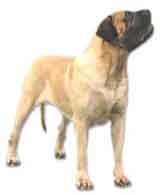Big DogsInformation About The Mastiff Dog Breed |
|
|
History and origin : The Mastiff, also known as Old English Mastiff, is one of the original ancient breed types, along with the hounds, herders, and Arctic types. He was distributed around the known world by Egyptian, Persian, Greek, and Roman armies and traders. Peasants in England kept this breed to ward off wolves and other predators. The Mastiff was bred for size, strength, protection, and courage. Description : The Mastiff stands 27 to 32 inches at the shoulder and weighs between 150 and 200 pounds. He is a massive, large-boned, and muscular breed. His shedding coat is short and coarse, with a dense short undercoat. Maintenance is low, needing only periodic brushing. The color may be fawn, apricot, or brindle, usually with a black muzzle, ear and nose. About the breed : The Mastiff is a laid-back breed with great strength and a very protective attitude. He is naturally dominant, brave, territorial, and suspicious of strangers. In addition, this breed is intelligent, loyal, good-natured, and also makes an excellent guard. Though affectionate with his owners and good with his family's children, he may be suspicious of other children. Because of his huge size, he can hurt a child while playing. He can also be quite aggressive toward other dogs and small pets. He needs early training and socialization. The training should be patient, precise, and never overbearing. Remember that a six-month-old Mastiff may weigh 90 pounds but still have the mind-set of a puppy. Though lethargic, he does need daily exercise. However, do not jog with this huge, heavy breed because the strain could eventually result in structural problems. It is important to show the Mastiff that you are the leader of the pack. A Mastiff can show explosive power with little warning when he turns aggressive. Strong confident leadership and plenty of socialization are mandatory. The Mastiff is short-lived and can suffer from hip dysplasia, bloat, heart problems, eyelid problems, and flatulence. Feeding : Recommended feeding for this breed is at least 2 ½ cans (13.3oz) of a high-quality meaty product with biscuit added in equal amount or 5 cupfuls of a complete, dry dog food. This breed eats large quantities of food. Ideal home : The Mastiff needs a house with a big-fenced yard. The owner of this breed must be a strong, confident, patient leader who prefers a dog with a protective nature. He is great for families only if the children are older and physically able to work the dog in obedience. Cautious and physically weak persons will create a pushy dog that lacks confidence and may have the tendency to bite. Harsh, overbearing types should also avoid this breed because they might create a fearful mind-set that could result in aggression. The elderly and the disabled should avoid this powerful breed. Time to train, socialize, and exercise is important and must be available. Back to the Big Dog Breed article page
| |
|
Related News About Dogs ' ); // get rid of newsfeed display by carp CarpConf('poweredby',''); CarpCacheShow('http://classifieds.agriscape.com/syndicate/dogs.rss'); ?>
|
|
|
|
|
|
Copyright © 2006-2007 dogguidance.com |


